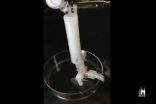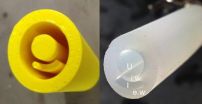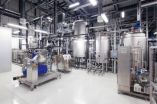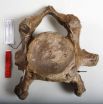(Press-News.org) DURHAM, N.C. -- For the millions of people forced to rely on a plastic tube to eliminate their urine, developing an infection is nearly a 100 percent guarantee after just four weeks. But with the help of a little bubble-blowing, biomedical engineers hope to bring relief to urethras everywhere.
About half of the time, the interior of long-term urinary catheters become plagued by biofilms -- structures formed by colonies of bacteria that are extremely difficult to kill. Once established, it is only a matter of time before the biofilm becomes a welcoming host for other, more dangerous bacteria or begins to choke urine drainage, causing leakage -- or even trauma to the patient's body.
Duke University engineers have developed a new urinary catheter design that can eliminate nearly all of the hard-to-kill biofilm from the catheter's walls. Instead of focusing on expensive antibacterial coatings, the researchers use physical deformation to knock the infectious film from its moorings.
"A biofilm is like a city that protects and harbors harmful bacteria," said Vrad Levering, a PhD student in biomedical engineering. "Our solution is like an earthquake that demolishes the infrastructure, leaving the rubble to be easily washed away by a flood of urine."
The study appears online March 25 in Advanced Healthcare Materials.
One in five people admitted to the hospital requires a urinary catheter, contributing to the more than 30 million used each year in the United States. These catheters are the number-one cause of hospital-acquired infections in the United States.
Outside of the hospital, catheters are also commonly required by paralysis victims and the immobile elderly. And with an aging population, the use of catheters is likely to increase in coming decades.
For years, researchers have focused on developing antimicrobial treatments to stop the formation of biofilms, but as the statistics indicate, they have yet to find an affordable, effective solution. Besides the costs and technical challenges, many doctors fear antimicrobial solutions would promote the evolution of antibiotic-resistant superbugs.
So Duke engineers decided to think outside of the cylinder.
"We ran experiments showing that if you stretch an elastic piece of rubber at a proper rate, you can pop various types of sticky biofilms right off of its surface," said Xuanhe Zhao, professor of mechanical engineering and materials science, whose team partnered with that of Gabriel Lopez, professor of biomedical engineering.
"Those tests were initially aimed at cleaning submerged surfaces in marine environments, but the principle has many possible applications," continued Lopez. "So we thought, why not catheters?"
Their first model features a single channel that can be inflated with liquid or air running parallel to the main urinary tract, with nothing but a thin, flexible barrier between the two. Pushing liquid through the small inflation channel forces the thin wall into the urinary tract while leaving the outer dimensions of the catheter intact.
A prototype molded from a 3D printed form worked beautifully, Levering said. The sudden deformation unseated more than 90 percent of the biofilm, which was washed away by a flow matching the slow movement of urine. Biofilm on the wall opposite the inflation channel was mostly unharmed, but the collaborative team has plans to produce a new prototype with inflation channels running along both sides of the main channel.
Lopez believes the demonstration is a clear proof-of-principle that their simple mechanical solution could revolutionize the catheter industry. Because the design would have low implementation costs, closely adheres to the dimensions of current catheters and would be easy for medical clinicians to operate, the team hopes to bring it to market and is currently searching for partners.
VIDEO:
This prototype catheter has been rinsed for 20 seconds without removing the biofilm. Pressurizing the inflation channel with water deforms the main channel, dislodging the white biofilm which is then...
Click here for more information.
"There are more than 30 million of these used every year," said Levering. "And for a technology that has changed very little in 50 years, the problem is kind of atrocious. We hope we have found a solution."
Levering said the general concept has potential applications for a wide range of industries currently plagued by biofilms, such as dairy processing, petroleum transport, city drinking water and heat exchangers.
"We don't want to get in over our heads, but there are lots of other places where biofilms are severe problems," said Levering. "It's a multi-billion-dollar-per-year problem for sea water filtration alone. There are definitely other potential markets out there."
INFORMATION: The research was a collaboration between the Lopez and Zhao groups that, besides Levering, includes Qiming Wang, a PhD student in mechanical engineering and materials science, and Phanindhar Shivapooja, a PhD student in biomedical engineering.
This work was supported by the National Science Foundation's Research Triangle Materials Research Science and Engineering Center (DMR-1121107), the Office of Naval Research (N0014-13-1-0828) and National Institutes of Health Training Grant (#5T32GM008555-18).
"Soft Robotic Concepts in Catheter Design: an On-demand Fouling-release Urinary Catheter," Levering, V., Wang, Q., Shivapooja P., Zhao, X., Lopez, G.P. Advanced Healthcare Materials, 2014. DOI: 10.1002/ ((ADHM.201400035))
Catheter innovation destroys dangerous biofilms
New design could reduce threat of infection from millions of urinary catheters
2014-03-25
ELSE PRESS RELEASES FROM THIS DATE:
Doxorubicin alone or with ifosfamide for treating soft tissue sarcoma?
2014-03-25
An EORTC study published in The Lancet Oncology does not support administration of intensified doxorubicin and ifosfamide for palliation of advanced soft tissue sarcoma, unless the objective is to shrink the tumor.
Dr. Ian Judson of the Royal Marsden Hospital in London and coordinator of this study says, "Our clinical trial was designed to compare combination treatment with doxorubicin and ifosfamide to treatment with doxorubicin alone, and our results show that the combination chemotherapy did not improve overall survival. So, if the goal of treatment is to control the ...
Leading surgeons warn against media hype about tracheal regeneration
2014-03-25
Beverly, MA, March 24, 2014 – Reports of the two earliest tissue-engineered whole organ transplants using a windpipe, or trachea, created using the patient's own stem cells, were hailed as a breakthrough for regenerative medicine and widely publicized in the press. However, two leading transplant surgeons in Belgium warn of the dangers of media attention, and urge that tracheal bioengineering be demonstrated as both effective and safe before further transplants take place. Their views are published in an Editorial in The Journal of Thoracic and Cardiovascular Surgery, an ...
Research study takes deeper look at the role of gut microbes in the immune system
2014-03-25
LOS ANGELES (March 24, 2014) – New research suggests that gut microorganisms do not merely influence immune cell function, but also support the production of immune cells that form the first line of defense against infection. By understanding the mechanisms responsible for maintaining and replacing immune cells, researchers hope to one day develop targeted therapies to support and boost immune function in humans.
Study investigators from the Regenerative Medicine Institute at Cedars-Sinai collaborated with the Mount Sinai School of Medicine and lead institution — the ...
Replacing insulin through stem cell-derived pancreatic cells under the skin
2014-03-25
LA JOLLA, Calif., March 25, 2014 – Sanford-Burnham Medical Research Institute (Sanford-Burnham) and UC San Diego School of Medicine scientists have shown that by encapsulating immature pancreatic cells derived from human embryonic stem cells (hESC), and implanting them under the skin in animal models of diabetes, sufficient insulin is produced to maintain glucose levels without unwanted potential trade-offs of the technology. The research suggests that encapsulated hESC-derived insulin-producing cells hold great promise as an effective and safe cell-replacement therapy ...
Complex brain functional network connection after stroke
2014-03-25
Studies have shown that functional network connection models can be used to study brain network changes in patients with schizophrenia. A research team from Huazhong University of Science and Technology in China inferred that these models could also be used to explore functional network connectivity changes in stroke patients. The researchers used independent component analysis to find the motor areas of stroke patients, which is a novel way to determine these areas. Functional magnetic resonance imaging datasets were collected from healthy controls and right-handed stroke ...
Technofossils -- an unprecedented legacy left behind by humans
2014-03-25
A new study by an international team of scientists, including Dr Jan Zalasiewicz and Professor Mark Williams of the University of Leicester's Department of Geology, suggests that the fossil impact humans have made on the planet is vast and unprecedented in nature – and that there's been nothing remotely like it since the Earth formed, over four and half billion years ago.
The study, entitled 'The technofossil record of humans' and published by SAGE in The Anthropocene Review, argues that, like dinosaurs, who left their bones and footprints behind for future generations ...
Managing renewables intelligently
2014-03-25
"Wind, solar and biogas are all energy sources with their own strengths and weaknesses. And it's by combining the strengths of each in a smart way that we'll be able to guarantee Germany's energy supply into the future," says Dr. Kurt Rohrig, deputy director of the Fraunhofer Institute for Wind Energy and Energy System Technology IWES in Kassel. But what happens when, instead of a big power plant, you have a host of individual small energy producers feeding in energy to the grid at varying times? Is reliable operation of the grid still technically feasible? In the "Combined ...
Sugar, not oil
2014-03-25
Plastic, gasoline, rubber – very many items we use every day are based on oil. But this raw material is becoming increasingly scarcer. Step by step researchers are therefore investigating possibilities for using renewable raw materials to replace oil. One well-known example of this is biodiesel, which comes not from oil sources, but from fields of yellow-flowering rape. In future it is planned to produce another substance from plants, namely isobutene, a basic chemical used in the chemical industry to produce fuels, solvents, elastomers or even antiknock agents in fuel. ...
Plasma tool for destroying cancer cells
2014-03-25
Plasma medicine is a new and rapidly developing area of medical technology. Specifically, understanding the interaction of so-called atmospheric pressure plasma jets with biological tissues could help to use them in medical practice. Under the supervision of Sylwia Ptasinska from the University of Notre Dame, in Indiana, USA, Xu Han and colleagues conducted a quantitative and qualitative study of the different types of DNA damage induced by atmospheric pressure plasma exposure, the paper is published in EPJ D as part of a special issue on nanoscale insights into Ion Beam ...
Neck ribs in woolly mammoths provide clues about their decline and eventual extinction
2014-03-25
Researchers recently noticed that the remains of woolly mammoths from the North Sea often possess a 'cervical' (neck) rib—in fact, 10 times more frequently than in modern elephants (33.3% versus 3.3%). In modern animals, these cervical ribs are often associated with inbreeding and adverse environmental conditions during pregnancy. If the same factors were behind the anomalies in mammoths, this reproductive stress could have further pushed declining mammoth populations towards ultimate extinction.
Mammals, even the long-necked giraffes and the short-necked dolphins, almost ...
LAST 30 PRESS RELEASES:
Researchers identify gene that calms the mind and improves attention in mice
Artificial metabolism turns waste CO2 into useful chemicals
Ancient sea anemone sheds light on animal cell type evolution
Begging gene leads to drone food
How climate policies that incentivize and penalize can drive the clean energy transition
Can community awareness campaigns in low-resource areas improve early diagnosis of colorectal cancer?
Stardust study resets how life’s atoms spread through space
Practical education: Clinical scenario-based program development
The impact of family dynamics on eating behaviour – how going home for Christmas can change how you eat
Tracing the quick synthesis of an industrially important catalyst
New software sheds light on cancer’s hidden genetic networks
UT Health San Antonio awarded $3 million in CPRIT grants to bolster cancer research and prevention efforts in South Texas
Third symposium spotlights global challenge of new contaminants in China’s fight against pollution
From straw to soil harmony: International team reveals how biochar supercharges carbon-smart farming
Myeloma: How AI is redrawing the map of cancer care
Manhattan E. Charurat, Ph.D., MHS invested as the Homer and Martha Gudelsky Distinguished Professor in Medicine at the University of Maryland School of Medicine
Insilico Medicine’s Pharma.AI Q4 Winter Launch Recap: Revolutionizing drug discovery with cutting-edge AI innovations, accelerating the path to pharmaceutical superintelligence
Nanoplastics have diet-dependent impacts on digestive system health
Brain neuron death occurs throughout life and increases with age, a natural human protein drug may halt neuron death in Alzheimer’s disease
SPIE and CLP announce the recipients of the 2025 Advanced Photonics Young Innovator Award
Lessons from the Caldor Fire’s Christmas Valley ‘Miracle’
Ant societies rose by trading individual protection for collective power
Research reveals how ancient viral DNA shapes early embryonic development
A molecular gatekeeper that controls protein synthesis
New ‘cloaking device’ concept to shield sensitive tech from magnetic fields
Researchers show impact of mountain building and climate change on alpine biodiversity
Study models the transition from Neanderthals to modern humans in Europe
University of Phoenix College of Doctoral Studies releases white paper on AI-driven skilling to reduce burnout and restore worker autonomy
AIs fail at the game of visual “telephone”
The levers for a sustainable food system
[Press-News.org] Catheter innovation destroys dangerous biofilmsNew design could reduce threat of infection from millions of urinary catheters





